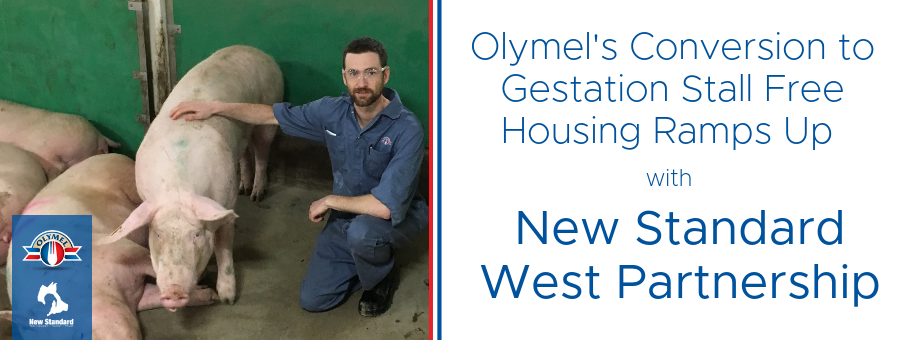
Olymel L.P. is Canada's leader in the production, processing and distribution of pork and poultry meats and is Canada’s largest hog producer. The company has made feeding the world its mission, which it pursues passionately with products of impeccable quality. The company employs over 12,000 people and has production and processing facilities in Quebec, Ontario, Alberta, New Brunswick and Saskatchewan. Olymel exports nearly a third of its total sales. Its annual sales are on the order of $3.5 billion.
A Commitment to Animal Welfare
In 2013, Olymel made the commitment to convert company owned facilities to gestation stall free housing, or GSF, by the year 2022. Since then they have been working to convert each of their sow barns to the new system incorporating the most advanced animal friendly technology available..
New Standard West is proud to be partnering with Olysky, a subsidiary of Olymel with their conversion to gestation stall free housing. Olysky along with its sister companies Olynorth and Olypork have more than 58,000 sows in production in Saskatchewan and Alberta producing more than 1.2 million market hogs annually for the Olymel slaughter plant in Red Deer, Alberta.
The Olysky Conversion
Colin Pratt (pictured above), Senior Production Manager and Chair for the Gestation Stall Free projects described his work with New Standard on this project. Pratt explained,
The project started with an internal review of a variety of systems and a review of how our existing farms could be converted to GSF. One of the first things we did was talk to other producers and visit some farms in operation. A great online resource was NSHCP's Group Sow Housing website put together by Canadian producers. This allowed a good understanding of the different production models used in group sow housing.
Choosing Preimplantation and Large Dynamic Groups
As Pratt and his team looked at the details of converting their barns, they knew their biggest decisions would be whether to do pre or post-implantation reentry and whether to use small static or large dynamic groups. After careful consideration the team chose to implement pre-implantation re-entry with large dynamic groups.
Pratt reflected on their choice to implement pre-implantation reentry in their barns:
There are many benefits to a pre-implantation system that you can realize once you get over the traditional belief that a post-implantation system has better performance, which is just not the case. Some of the benefits are the use of heat detection units, less sow movements from barn to barn, and given that the point of these conversions is to have sows spent more time in pens vs. stalls a pre-implantation system only has sows in stalls for 5% of gestation vs. 30% in a post-implantation system.
The team's main reasons for selecting large dynamic groups over small static were the way a large dynamic system better utilized their space with minimal concrete costs, the fact that in a dynamic group more of their space was productive space, and the ability to better use technology to lessen staffing needs. Technologies such as automatic marking, heat detection and central separation just aren't as feasible with small static systems.
Why New Standard?
The equipment Pratt and the OlySky team selected for the conversion was Nedap ESF provided by New Standard. Ultimately, they made the decision largely based on Kees van Ittersum's knowledge and expertise. Pratt explained,
New Standard was able to provide the design expertise to convert the different sow farm designs in our company. Kees' knowledge of retrofit farm design allowed for a complete look at what the farms would be like when completed. Match that with an understanding of sow behavior and we knew the system design would be a success.
Olymel's commitment to animal welfare and Pratt's passion for good animal husbandry in his barns has been a good fit for New Standard as well. OlySky and New Standard completed the conversion of the Merkosky sow unit, a 2,500 sow multiplier, in April of 2018. They will also complete the Sawka 2,700 sow unit in September 2018, and plan to start converting Korchinski, a 6,000 sow unit, in October of 2018.





